Flash recap ⚡
In the US; stocks pulled back on inflation and interest rate fears. Growth stocks fared worse than value shares. The debt ceiling and stimulus uncertainty continue to weigh. Supply constraints feed inflation worries. Corporate issuance continues to see strong demand.
In the EU; Strong inflation in eurozone, but ECB’s Lagarde says it’s temporary. BoE’s Bailey says UK growth slower than expected. Germany faces months of coalition haggling.
In Japan; Little change expected as Kishida moves closer to becoming prime minister. As political leadership changes, BoJ chief affirms stimulative monetary policy.
In China; News of the asset sale came as Beijing is prodding government-owned companies and state-backed property developers to buy some of Evergrande’s assets. Ultimately, Beijing will likely focus on managing the social fallout of Evergrande’s unfinished housing units, followed by property supply chain suppliers owed money by the company.
Monday, September 27th
Graphic 1: Inventories at European storage facilities are at historically low levels 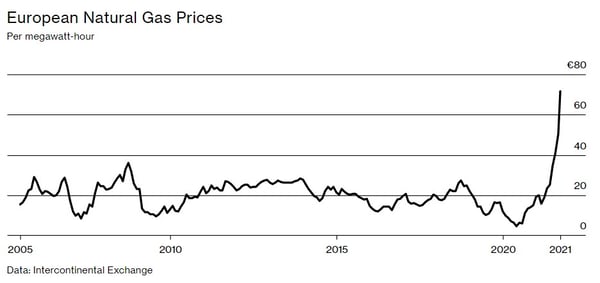
Pipeline flows from Russia and Norway have been limited. That’s worrying as calmer weather has reduced output from wind turbines while Europe’s aging nuclear plants are being phased out or are more prone to outages—making gas even more necessary. No wonder European gas prices surged by almost 500% in the past year and are trading near record.
Graphic 2: Oil is flirting with a 3-year high on global energy crunch
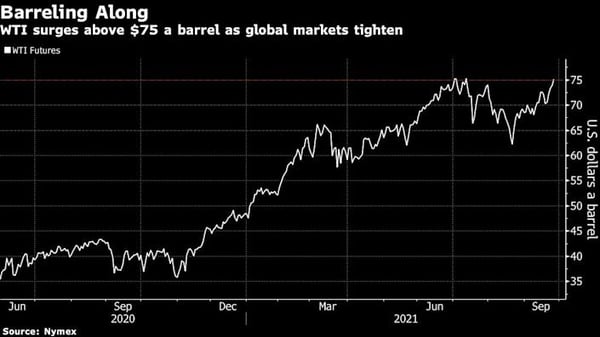
Oil rallied at the start of the week as the market is showing signs of a tightening supply. West Texas Intermediate tapped in the $75 range on Monday trading. Oil price has risen 80% over the past year as there was a worldwide renewed demand since the pandemic recovery. A stronger than expected demand in the near term combined with a consciously tightened supply could make prices rise even higher.
Tuesday, September 28th
Graphic 3: Coal prices are soaring , miners struggle to boost output
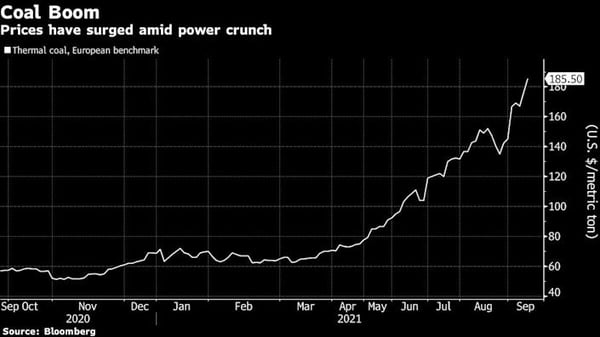
Due to a labor shortage and a reluctance to open new mines, the US coal offer struggles to keep up with demand. Coal prices are also up 40% in China, while in Europe, they almost tripled since the start of the year. Deliveries are also running two to four weeks late. This is all de to a global recovery that drives an unseen demand for more power.
Graphic 4: Business activity is slowing as opposed to price levels
There is a growing divergence between business activity versus prices. More specifically we are looking at the Dallas Fed Manufacturing outlook. Inflation is going upwards at historical highs. The set of policies to fix one problem would worsen the other it seems? Keep in mind that a similar divergence occurred prior to the Global Financial crisis.
Wednesday, September 29th
Graphic 5: MSCI EM index is down on the back of soaring prices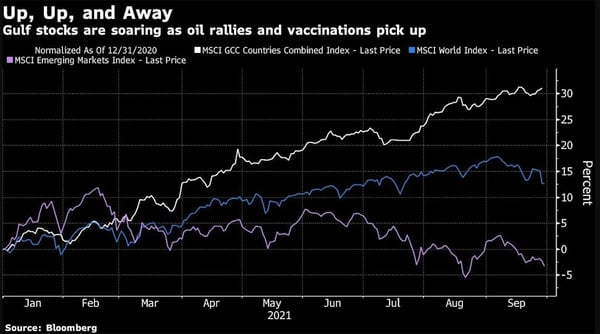
An MSCI emerging market index shows depreciating levels of output for EM companies, but on the other hand, and looking at an index tracking the United Arab Emirates, Saudi Arabia and other Gulf States has notched gains for 11 straight months, the longest winning streak ever.
Graphic 6: Surging treasury yields is kryptonite for the Nasdaq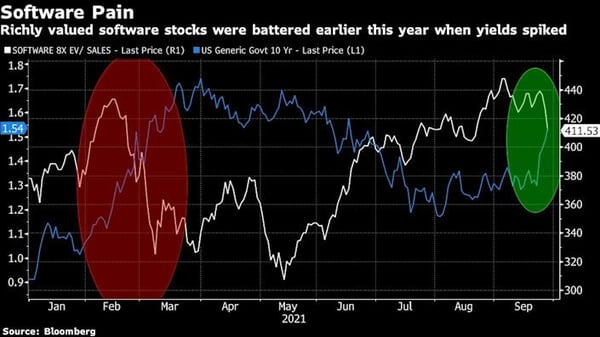
There was already a sell-off in software companies after rising yields, and this is because rising yields are lethal for high growth tech company valuations. In order to value these stocks, analysts use bond yields to discount future earnings into present dollars. And the higher yields go, the less valuable future profits appear.
Thursday, September 30th
Graphic 7: Swiss equities lose momentum as investors jump into value stocks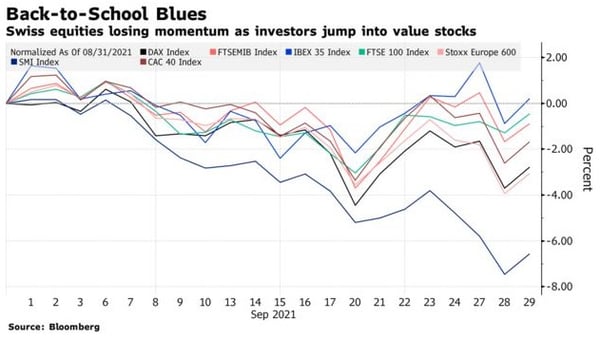
The Swiss Market Index (SMI) is down 6.3% in September, poised for its worst pandemic-era showing and the biggest decline among Europe’s main equity gauges, as mounting risks from a surge in bond yields and China Evergrande Group’s woes drive investors away from the country’s highly valued stocks.
Graphic 8: The USD is making a comeback to November 2020 levels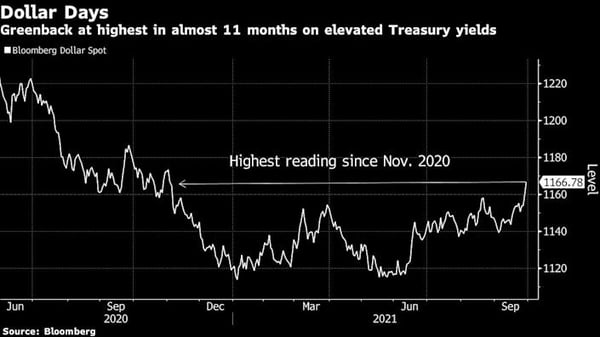
As Treasury yields keep rising, the greenback has been sent to its highest level in almost a year. The dollar outperformed all of its Group-of-10 peers, with the New Zealand dollar and Norwegian krone among the biggest losers. The euro declined to a 10-month low.
Friday, October 1st
Graphic 9: China orders energy companies to secure supply at all costs
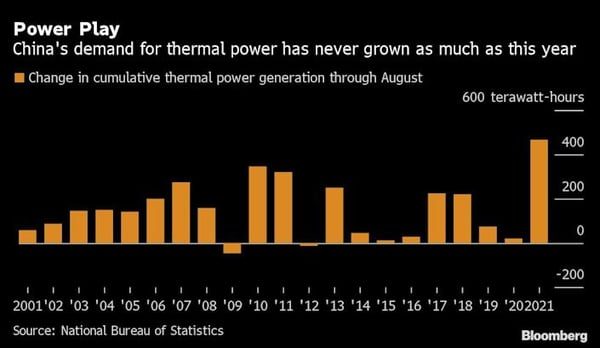
As China is about to face a freezing winter, which could lead to an energy crisis, the government ordered state-owned energy companies to secure supplies for this winter at all costs.
Graphic 10: Overall bad month for equities 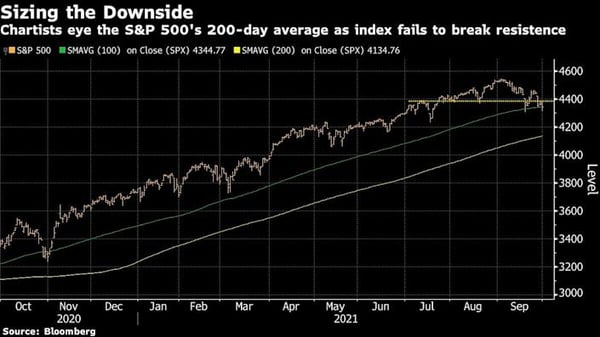
The end of September brought a lot of volatility and economic unease to financial markets. However, selloffs were rather modest, and there was not concrete sign of catastrophe. Investors should anyways remain attentive and careful. “Until we see a washout or impulsive buying, a move to the 200 DMA on the S&P 500 can’t be ruled out,” said John Kolovos, chief technical strategist at Macro Risk Advisors.





